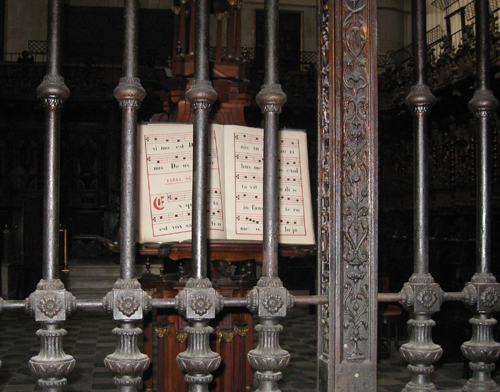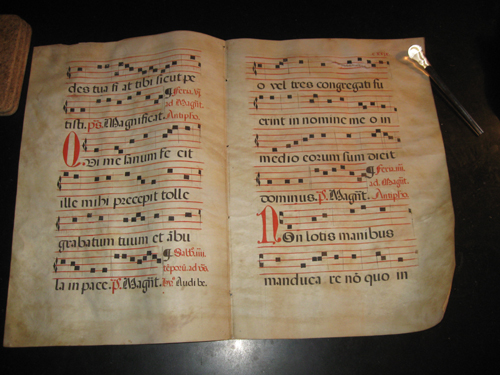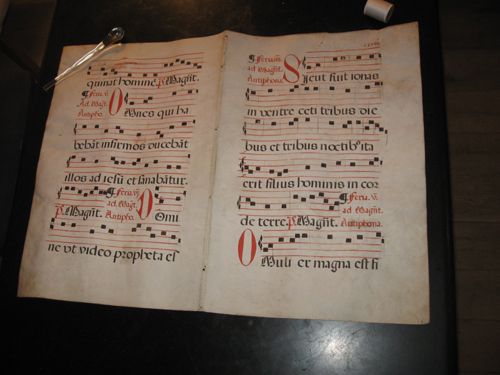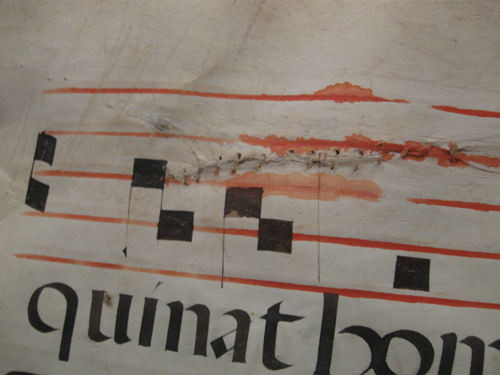When we were in Cadiz visiting the cathedral last month we noticed a most interesting lectern near where the choir sang.
As Síle has been singing in choirs for many years she was particularly interested in their method of following the words and the music.

Instead of each member holding individual scores this large sheet was placed where everyone could see it and follow.
Last Saturday Síle and I went to a Vide Grenier in our next door village Corneilhon.
We went through the entire selection of stalls and were heading back to the car empty handed when Síle started to rummage in an old trunk full of old tatty books. She found an old book of christmas songs , “Deux Euro” , said Madame.
I found a scroll of tatty paper and held it up “Deux Aussi” said madame.

This is what I had found , it was a page from an old hymnal which was just the same as that in Cadiz.
It obviously came from a book as it was written on both sides.
The whole page was about 42 inches (112 cm) wide and about 15 inches(38cm. ) tall
I say written deliberately as there was no mistaking that the sheet was meticulously drawn by hand.
It is obviously some sort of canticle or antiphon sung by a choir at church.

It was at one time a thing of great value.
Look carefully at the top left hand corner of this side.

There is a very carefully hand stitched mend of a tear.
I don’t suppose there is anyone reading this who is sufficiently familiar with the church canon to tell me what the hymn was but I am glad that I will be able to treasure it as it was before, and give it a totally suitable home in Le Presbytere.

Comments
Peter
on November 8, 2010It appears to be a gregorian chant setting of John, 5.11 – a version of take up your bed and walk. No, I’m not an expert on the (a?) church canon – just a nerd who can’t resist a challenge.
Martin
on November 9, 2010No nerd sir but a man of rare erudition. I doff my (canonical) hat.
Martin
on November 9, 2010Sudden blinding flash of illumination :
these communal pages must have been the origin of the phrase “singing from the same hymn sheet ”
martine
on November 9, 2010Maria de la O’s spirit is on you, that’s for sure!
Martin
on November 9, 2010Oh-ho ! Scarey !
Peter Flynn
on November 11, 2010Síle is quite right: in the days before printing, sharing one score was normal: they were too expensive to copy for everyone. Fortunately those were the days before 4-part harmony 🙂
The book in Cadiz is open at the Antiphon “Ex quo facta est vox salutationis” after the 5th Psalm (Lauda Jerusalem) at 2nd Vespers for feasts of the 2nd July.
Your own manuscript is similar, but a different style and writing. It’s a whole sheet, so when bound, the left-hand half would have been in a different part of the book from the right-hand half, because they were bound in 4s, 8s, or 16s called “signatures”.
These pages show Antiphons preceding the Magnificat at Vespers; starting with the right-hand half of the last photo, we have the Antiphons for Wednesday to Friday of the 1st week in Lent:
“Sicut fuit Jonas” (For as Jonas was three days and three nights in the whale’s belly;)
“O mulier” (O woman, great is thy faith: be it unto thee even as thou wilt.)
over the page to the left-hand half of the middle photo:
“Qui me sanum” (He that made me whole, the same said unto me, Take up thy bed, and walk.)
Starting with the right-hand half of the middle photo, we have those for the Tuesday to Friday after the 3rd Sunday in Lent:
[end of] “Ubi duo vel tres” (Where two or three are gathered together in My name)
“Non lotis manibus” ([but] to eat with unwashen hands defileth not a man)
“Omnes qui habebant” (All they that had any sick with divers diseases brought they unto him)
[start of] “Domine ut video” (Sir, I perceive that thou art a prophet)
This may well have come from a Vesperale or an Antiphoner, which were subsets of the Liber Usualis, as the whole book would have been far too big and heavy (even printed, it’s over 1,500 pages).
Martin
on November 11, 2010My Goodness Peter Flynn I am so very impressed.
Thank you.
I will keep your translations to hand when I manage to get this framed.
Bravo.
Peter
on November 13, 2010H’m – “Take up thy bed and walk” . . . Not very appropriate for a Chambre d’hote, is it?
Martin
on November 13, 2010Thanks Peter D will have to make sure that the other side of the hymn sheet is the one on show. Otherwise we may have teams of Latin scholars running off with the lecti.
The comments are closed.